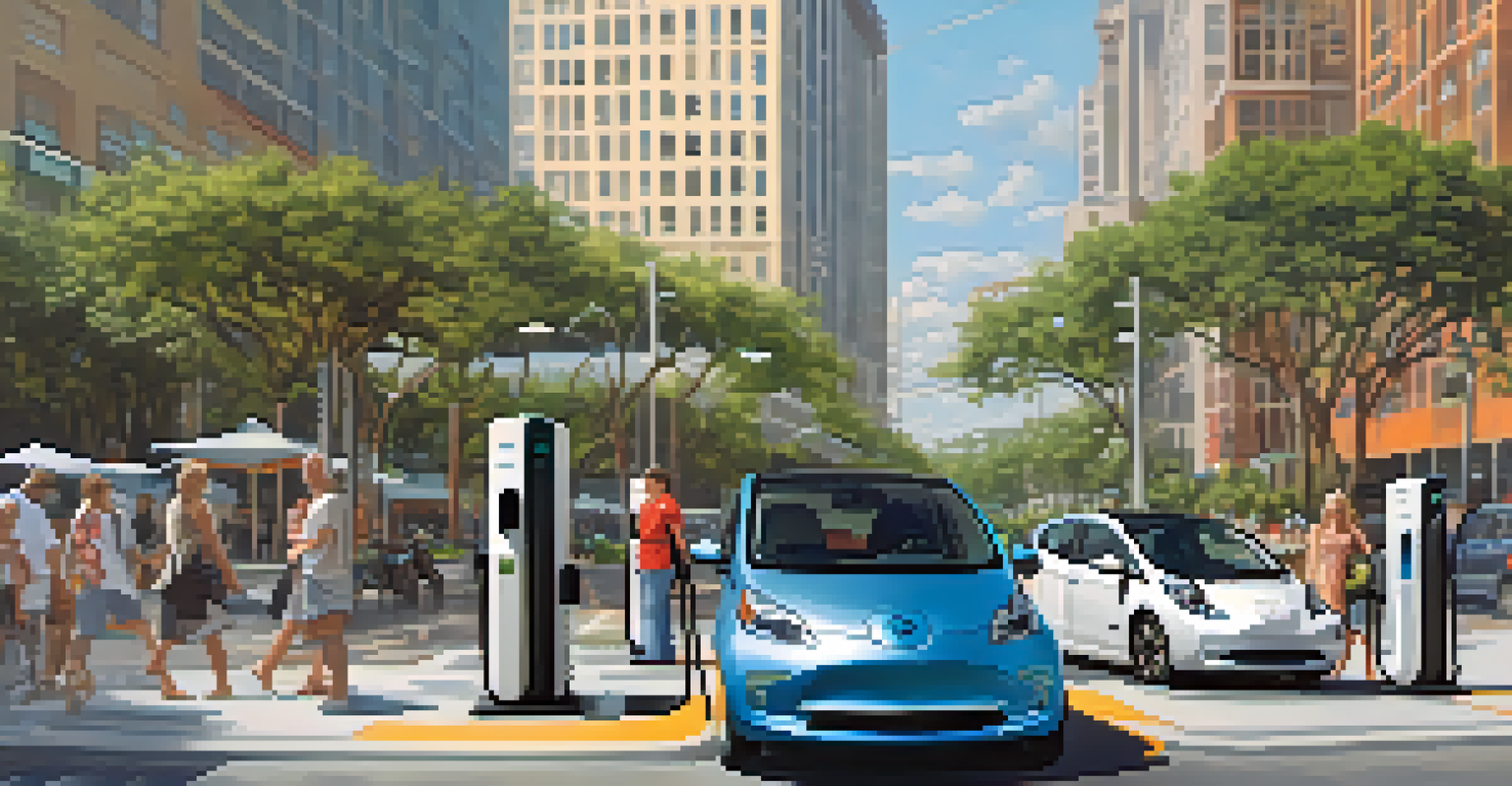Tampa's Renewable Energy Goals: Progress and Challenges

Understanding Tampa’s Renewable Energy Goals
Tampa has set ambitious renewable energy goals aimed at reducing carbon emissions and fostering sustainability. The city aims to derive 100% of its energy from renewable sources by 2040, which is a significant commitment. This goal aligns with broader state and national initiatives focused on combating climate change and promoting cleaner energy. By establishing these targets, Tampa seeks to lead by example in the transition toward sustainable energy solutions.
The future will be powered by renewable energy, but it will take a collective effort to get there.
A major component of these goals is increasing the use of solar energy, which has immense potential in Florida due to its sunny climate. Solar panels on rooftops and solar farms are becoming more common, providing both residential and commercial properties with clean energy options. Additionally, Tampa is exploring wind and biomass energy as viable alternatives to traditional fossil fuels.
The city’s commitment to renewable energy not only contributes to environmental sustainability but also has economic implications. By investing in renewable infrastructure, Tampa can create jobs in the green technology sector, boosting the local economy. This dual focus on sustainability and economic growth showcases Tampa's holistic approach to addressing energy needs.
Progress Made in Renewable Energy Implementation
In recent years, Tampa has made notable strides in implementing renewable energy solutions. The city has partnered with local utilities to expand solar power installations, significantly increasing capacity. For instance, the development of community solar programs allows residents to participate in renewable energy without needing to install their own solar panels.

Moreover, Tampa Electric Company has committed to investing in renewable projects, including solar farms that produce energy for thousands of households. This partnership not only helps meet energy demands but also educates the community about the benefits of renewable sources. As a result, public awareness and acceptance of renewable energy have grown significantly.
Tampa's Renewable Energy Goals
Tampa aims to achieve 100% renewable energy by 2040, focusing on sustainability and economic growth.
In addition to solar initiatives, Tampa is also exploring energy efficiency programs aimed at reducing overall consumption. These programs include offering incentives for residents and businesses to adopt energy-efficient appliances and practices. The combination of these efforts illustrates a comprehensive strategy toward achieving Tampa’s renewable energy goals.
Community Involvement in Renewable Energy Efforts
Community involvement plays a crucial role in Tampa's renewable energy initiatives. Local organizations and citizens have been actively engaged in advocating for sustainable practices. They participate in public forums and workshops, providing input on energy policies and sharing insights on community needs.
Sustainability is no longer about doing less harm. It's about doing more good.
One of the key outreach efforts has been educational programs in schools to teach students about renewable energy and its importance. By fostering a culture of sustainability among the younger generation, Tampa is building a future workforce that values and understands renewable technologies. This grassroots involvement creates a sense of ownership and accountability within the community.
Furthermore, community solar projects allow residents to invest in renewable energy collectively, making clean energy accessible to those who might otherwise be unable to afford it. This inclusive approach not only strengthens local bonds but also ensures that the benefits of renewable energy are shared broadly across different socioeconomic groups.
Challenges Facing Tampa's Renewable Energy Goals
Despite the progress, Tampa faces several challenges in achieving its renewable energy goals. One major hurdle is the upfront cost of renewable technologies, which can deter some homeowners and businesses from making the switch. While long-term savings are expected, the initial investment can be a barrier, especially for lower-income residents.
Additionally, regulatory and policy frameworks can complicate the implementation process. Navigating through local, state, and federal regulations requires significant coordination and can slow down project timelines. Uncertainties in policy direction can also impact investment decisions in renewable projects.
Community Engagement is Key
Active community involvement fosters a culture of sustainability and ensures equitable access to renewable energy.
Another challenge is the need for infrastructure upgrades to support increased renewable energy sources. The existing grid may require enhancements to handle the intermittent nature of solar and wind energy. Addressing these infrastructure needs is essential for ensuring that Tampa can reliably harness and distribute renewable energy.
The Role of Technology in Advancing Renewable Energy
Technology plays a pivotal role in advancing Tampa's renewable energy goals. Innovations in solar panel efficiency and energy storage solutions are making it easier and more cost-effective to harness renewable resources. For instance, battery storage systems allow excess energy generated during the day to be stored for use at night, enhancing energy reliability.
Moreover, smart grid technology is transforming how energy is distributed and consumed. By utilizing real-time data, the grid can optimize energy flow based on demand, which is particularly beneficial for integrating renewable sources. This technological evolution ensures that the energy system is more resilient and adaptable to fluctuations in supply and demand.
Tampa is also exploring advanced energy management systems that can help businesses and households monitor their energy use more effectively. These systems provide insights into consumption patterns, enabling users to make informed decisions that can lead to energy savings. Ultimately, technology not only supports the transition to renewable energy but also empowers the community to participate actively in energy management.
Partnerships Driving Renewable Energy Growth
Collaboration is essential for Tampa’s renewable energy success, and partnerships with various stakeholders are key. The city has teamed up with local utilities, businesses, and environmental organizations to create a unified approach to renewable energy development. By working together, these entities can share resources, knowledge, and best practices.
For instance, partnerships with educational institutions have led to research initiatives focused on renewable technologies. These collaborations help identify innovative solutions tailored to Tampa’s unique climate and energy needs. Additionally, they provide students with hands-on experience in the renewable energy sector, fostering a skilled workforce for the future.
Challenges to Overcome
Tampa faces hurdles like upfront costs and infrastructure needs that must be addressed to meet its renewable energy targets.
Moreover, public-private partnerships are crucial for financing renewable projects. By leveraging investment from private companies, Tampa can accelerate the development of renewable infrastructure. This collaborative spirit not only enhances project viability but also ensures that multiple perspectives are considered in the planning and execution phases.
Looking Ahead: The Future of Renewable Energy in Tampa
As Tampa looks to the future, its commitment to renewable energy remains steadfast. The city is continuously evaluating its strategies and exploring new technologies to meet its ambitious goals. With ongoing community support and technological advancements, there is a sense of optimism about what lies ahead.
Future initiatives may include expanding electric vehicle (EV) infrastructure to promote cleaner transportation options. By investing in EV charging stations, Tampa can encourage residents to switch to electric vehicles, aligning transportation with its renewable energy objectives. This holistic approach connects various sectors, further enhancing sustainability efforts.

Ultimately, Tampa’s journey toward renewable energy is a collective effort that requires collaboration, innovation, and community engagement. By addressing challenges and building on successes, Tampa can pave the way for a greener, more sustainable future that benefits both its residents and the environment.